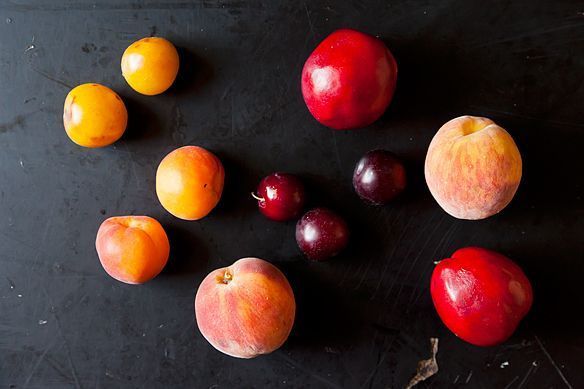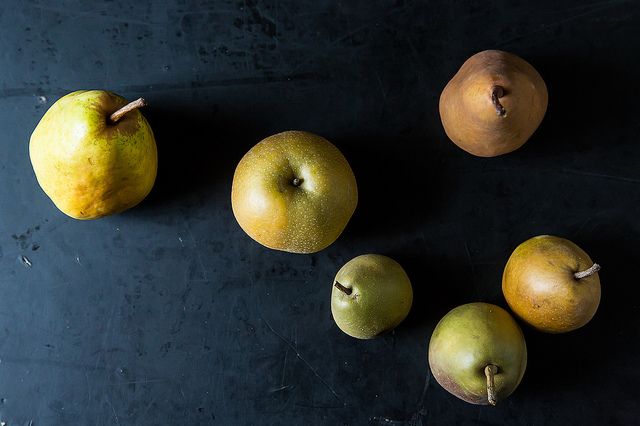We're bringing the Food52 community a little bit closer by sharing your food stories. Want to contribute? Send it to us at [email protected].
Today: A story of stolen fruit from Food52-er natasha saje -- and why it may taste so sweet.

First the sour cherries, then the black cherries, then the apricots, followed by the Elberta peaches, then small red and pale green plums, then fragrant white cling peaches, then red currants, followed by black currants, then the nectarines, then the early green apples, then the late yellow peaches, then the Italian plums, then the grapes: white seedless, red seedless, wine grapes, concords. Then the MacIntosh apples and the early Anjou pears, followed by the Bosc pears and Golden Delicious apples, and finally my favorite tart red apples.
All of these fall on the ground in my neighborhood in Salt Lake City, planted by one set of people and neglected by their successors, for whom the fruit is a nuisance, shoveled into the trash can. Add to this the wild fruit -- the chokecherries, Oregon grapes, the goji berries -- and my high desert lakebed is a dessert bowl of abundance, one that I pluck from June through October. We take a plastic bag each time we go for a walk, and we come home with it filled. If we forget a bag, we fill our pockets, our hips and buttocks looking lopsided and deformed by the bounty.
A recent study compared people who made their own sandwiches to a group whose sandwiches were made for them. Apparently, making one’s own meal decreases pleasure in consuming it. Apparently, thinking about the kind of olive oil, the slow-rising bread, the tomatoes from the market, the fleur de sel -- even writing these phrases makes the sandwich a real thing in one’s brain, and thus, a less desirable thing for the mouth. The brain has already consumed it, as it were.

This information comes as a bit of a relief, because after forty-some years cooking for others, I have never completely enjoyed eating the food I so carefully planned, shopped for, prepared, and served. At the point of sitting down to eat with my guests, not only have I been tasting everything multiple times, but my critical side has kicked in. Proust knew this: “Nothing is so satisfying as the imagination’s rendering of it."
It’s sad to love these two things -- cooking and eating -- so much and not be able to enjoy them simultaneously. This explains why people love restaurants, of course, and the addictive pleasure of reading cookbooks. Does it also explain why stolen fruit is more delicious? Because it is so serendipitous, so out-of-the-blue, so un-theorized? Because my mind has not already eaten the grapes as I purchased them?
Sometimes our scavenged fruit is blighted by worms or frost damage, but more often the fruit is perfect, and almost certainly not sprayed or even fertilized. Sometimes it is “kissed by bees” -- marked with tiny pinpricks, a sign of particular sweetness. Usually it is more flavorful than supermarket fruit or even fruit from the farmers market, probably because it is both tree-ripened and picked when ripe. And perhaps also because it is stolen.

We eat this fruit out of hand, of course, while walking, and I dehydrate, preserve, freeze, or make fruit crisps with the rest. And with the small apples, I make a savory side dish, originally developed for a guest allergic to pepper. I watched her eat a piece and then saw a look of horror come over her face. I reassured her that it did not contain any pepper and she took a few more incredulous bites. Small apples work particularly well because the dish tastes better with lots of apple skin and tart fruit.
More: Tips to read before picking your own apples, and tools to match.
Savory Stolen Apples
Serves 12
3 pounds apples, with skin
3 pounds carrots, scrubbed
6 tablespoons olive oil, divided
3 large cloves of garlic
3 ounces peeled ginger
1 tablespoon ground cumin
1 tablespoon ground cinnamon
1 tablespoon ground coriander
1 tablespoon sea salt
Get the full recipe (and save it and print it) here.
Photos by James Ransom





See what other Food52 readers are saying.